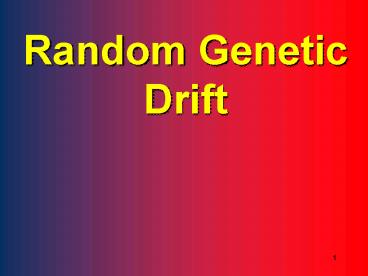Random Genetic Drift - PowerPoint PPT Presentation
1 / 40
Title:
Random Genetic Drift
Description:
Allele frequency changes can occur by chance, in which case the ... What is the effective population size of a honeybee hive? N 100,000. Nf = 1. Nm 1 ... – PowerPoint PPT presentation
Number of Views:343
Avg rating:3.0/5.0
Title: Random Genetic Drift
1
Random Genetic Drift
2
Conditions for maintaining Hardy-Weinberg
equilibrium
1. random mating 2. no migration 3. no
mutation 4. no selection 5. infinite population
size
3
2 mathematical approaches to studying genetic
changes in populations Deterministic
models Stochastic models
4
Drift
Allele frequency changes can occur by chance, in
which case the changes are not directional but
random. An important factor in producing
changes in allele frequencies is the random
sampling of gametes during reproduction.
5
Niche capacity 10 plants
6
- A simple idealized model
- All the individuals in the population have
the same fitness (selection does not operate). - The generations are nonoverlapping.
- Adult population size is finite does not
change from generation to generation. - Gamete population size is infinite.
- The population is diploid (N individuals, 2N
alleles). - One locus with two alleles, A1 and A2, with
frequencies p and q 1 p, respectively.
7
(No Transcript)
8
(No Transcript)
9
When 2N gametes are sampled from the infinite
gamete pool, the probability, Pi, that the sample
contains exactly i alleles of type A1 is given by
the binomial probability function
Since Pi is always greater than 0 for populations
in which the two alleles coexist (i.e., 0 lt p lt
1), the allele frequencies may change from
generation to generation without the aid of
selection.
10
The process of change in allele frequency due
solely to chance effects is called random genetic
drift.
11
Fixation
12
(No Transcript)
13
Magnitude of fluctuations depends on population
size. Large population Small fluctuations.
Small population Large fluctuations. Mean
time to fixation or loss depends on population
size. Large population Long time. Small
population Short time.
14
(No Transcript)
15
yet
16
(No Transcript)
17
Fixation by Drift on an Y-Linked Trait in a
Small Population
Family names!
18
Founders of Pitcairn Island population in
1789 30 males 12 family names
19
1998 Descendants 1930 males 1 family name
Adams
20
Random Genetic Drift Markov Process A random
process whose probabilities at each stage are
determined by its most recent values, i.e., a
process lacking historical memory.
21
An important property of random genetic drift is
its cumulative behavior i.e., from generation to
generation, the frequency of an allele will tend
to deviate more and more from its initial
frequency.
22
In mathematical terms, the mean and variance of
the frequency of allele A1 at generation t are
given by Mean frequency does not change
with time. Variance increases with time.
23
With each passing generation the allele
frequencies will tend to deviate further and
further from their initial values, however the
change in allele frequencies will not be
systematic in its direction.
24
Change in probability of not deviating from
initial frequencies with time
25
Random genetic drift is an important
evolutionary force
26
A summary
Selection may not change allele frequencies.
Allele frequencies may change without selection.
27
Effective population size
28
Population size the total number of individuals
in a population. From an evolutionary point of
view, however, the relevant size consists of only
those individuals that actively participate in
the reproductive process. This part is called
the effective population size and is denoted by
Ne.
29
Why isnt the census size satisfactory?
Some individuals may contribute little to the
reproductive potential of a population
30
Sewall Wright (1931) introduced the concept of
effective population size, which he rigorously
defined as the size of an idealized population
that would have the same effect of random
sampling on allele frequencies as that of the
actual population.
31
Assume a population with census size N and
frequency of allele A1 at generation t p. If
the number of individuals taking part in
reproduction N, then the variance of the
frequency of allele A1 in the next generation,
pt1, may be obtained from the variance equation
by setting t 1.
32
(No Transcript)
33
- Ne is usually much smaller than N
- Various factors contribute to this difference
- overlapping generations.
- variation in the number of offspring among
individuals. - number of males involved in reproduction is
different from the number of females. - long-term variations in population size.
- bottlenecks
34
Effects of inequality between numbers of males
and numbers of females on effective population
size
- Examples
- Polygamy social mammals, territorial birds.
- Nonreproductive castes social bees, ants,
termites, naked mole rats.
35
Formicoidea Isoptera
Heterocephalus glaber
36
If a population consists of Nm males and Nf
females (N Nm Nf), then Ne is given by
37
What is the effective population size of a
honeybee hive?
N 100,000 Nf 1 Nm gtgt 1 Ne 4
38
(No Transcript)
39
If a population goes through a bottleneck, the
long-term effective population size is greatly
reduced even if the population has long regained
its pre-bottleneck census size.
40
Historical human population sizes
Long-term (2 million years) effective population
size Ne 10,000































